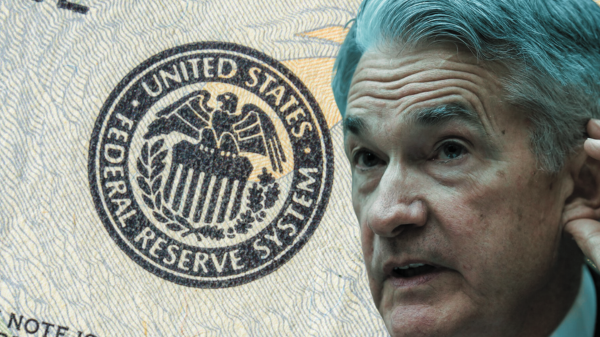Life, Liberty, Property #35: economic pain of high interest rates and rising prices won’t bring economic gain with out-of-control federal spending.
IN THIS ISSUE:
- Economic Pain for Economic Gain?
- College-Readiness Declines Again
- Biden Whacks For-Profit Higher Ed
- From ‘End of History’ to End of Civilization
- Cartoon
SUBSCRIBE to Life, Liberty & Property (it’s free). Read previous issues.
Economic Pain for Economic Gain?
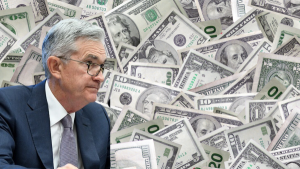 The end of the Federal Reserve’s decade-plus zero-interest-rate policy (ZIRP) regime has wrought much pain, as higher interest rates are squeezing consumers, businesses, and even the federal government:
The end of the Federal Reserve’s decade-plus zero-interest-rate policy (ZIRP) regime has wrought much pain, as higher interest rates are squeezing consumers, businesses, and even the federal government:

As I have noted regularly in this newsletter and elsewhere, the Fed’s formula for controlling inflation is to suppress the private sector’s production of goods and services. Having less economic activity is the Fed’s harsh and distasteful cure for the inflation caused by the monetarization of excessive federal government spending.
Having suppressed economic activity sufficiently to suit its taste for the moment, the Fed is contemplating keeping interest rates where they are—the highest in 22 years—and not raising them further for now. CNBC reports:
In recent days, multiple Fed officials have cited the tightened financial conditions brought on by a surge in Treasury yields as helping the central bank in its quest to slow the economy and bring down inflation.
The Fed governors are likely to keep interest rates high for a while, CNBC quotes Philadelphia Federal Reserve President Patrick Harker as saying:
“I do subscribe to the new moniker, ‘higher for longer.’ I didn’t coin it, but my expectation is that rates will need to stay high for a while,” he said.
Of course, the Fed partnered with the Democrat Congress and President Joe Biden in unleashing inflation through a radical and entirely unnecessary increase in government spending in 2021 and 2022 (keeping it well above the already-excessive earlier trend line) and the Fed’s monetary expansion to support it:
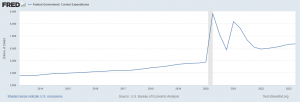

Here are a couple longer-term graphs showing the increase in the money supply:

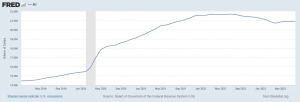
As the graphs indicate, the money supply had been steadily increasing for years before the pandemic, since the 2008-2009 recession, and then continued to rise after the pandemic boost, only starting to decline a little since the Fed started raising the fed funds rate and selling securities last year.
This easy money under ZIRP created all sorts of wasteful distortions in the economy by lowering the returns on non-risky investments—and, as a vivid example, unleashed unprofitable and economically damaging environmental, social, and governance (ESG) practices. The higher interest rates have begun to reverse that process, as economist Peter C. Earle noted earlier this year:
[T]he recent explosion of ESG adoption may have been in the spirit, if not embodying a strictly theoretical manifestation, of malinvestment as predicted by Austrian Business Cycle Theory (ABCT). Without engaging in a lengthy discussion of ABCT, artificially low interest rates (interest rates set by policymakers instead of markets) undercut the natural rate of interest, misleading entrepreneurs and business managers. Many years of negligible interest rates, indeed negative real rates, have given rise to bubble-like firms, projects, and I would argue, by extension, business concepts. The latter, which include but are not limited to ESG, seem feasible and arguably essential when the money spigots are open. When interest rates normalize and sobriety re-obtains, cost structures reassert themselves. It’s back to the business of business.
Gone are the salad days of easy money, and with it the schmaltzy wishlists of niceties which a decade of monetary expansion permitted activists to blithely force upon corporate executives. In the face of rising interest rates, an uncertain path for inflation, budget-constrained consumers and rapidly deteriorating corporate earnings, shareholders are likely to take a closer look at how and where their money is being spent than they have in some time.
The Fed gave distortions, and the Fed is now taking them away. Writing at the Financial Times, former Fed chair Sheila Bair says a painful economic contraction will create long-term benefits by removing the distortions the central bank created via extremely low interest rates:
Now that the Fed has shifted to a “higher for longer” stance to combat inflation, our economy will have to make painful adjustments to the rising cost of money. But we need to hold our course. Ultimately, higher rates will lead to a fairer, more productive and resilient economy.
In fact, Bair says, “higher interest rates are associated with higher economic growth,” contrary to prevailing thinking:
Take the “boom” years of 1982-1990 and 1991-2001, when annual gross domestic product growth of 4 per cent was typical, in comparison with the 2 per cent Zirp norm. In most of those boom years, short and long-term interest rates far exceeded the levels we see today. Households and businesses still borrowed. The economy hummed.
Tighter money forces investment toward capital’s most productive uses, thus maximizing the value of the goods and services people choose to produce, says Bair. Loose money creates waste, Bair writes:
Free money can actually undermine growth by making an economy less efficient. The more money costs, the more disciplined its allocation. If it’s costless to borrow, money flows into all sorts of unproductive uses. It flows into rampant speculation characterised by the crypto and meme stock crazes. It flows into zombie companies from indiscriminate investors seeking any decent yield. It harms competition by feeding industry concentrations. …
It encourages excessive levels of borrowing, while incentivising risk taking and speculation among investors searching for yield. As rates rise, bubbles pop, over-extended borrowers default. Even safe, low-yielding assets lose market value. Risks build in unregulated, non-transparent pockets of the financial system.
In addition to undermining economic growth, free money disproportionately benefits larger companies, thus increasing market concentration and reducing competition, while increasing economic inequality, Bair writes:
Research shows that larger companies disproportionately benefit from the lower rates, which they use to make acquisitions and other investments that increase their market dominance. As their market power grows, they lose incentives to remain agile and competitive as their smaller competitors fall further behind. I’m all for vigorous antitrust enforcement against anti-competitive behaviour. But the industry concentrations that so worry the Biden administration today may have as much to do with low rates as corporate misconduct.
Free money also exacerbates wealth inequality which is detrimental to an economy like ours in the US, which relies on middle class consumption to thrive. Concentrating wealth in the hands of a few diminishes the purchasing power of the rest. Zirp has done little for real wage growth, but it has done wonders in boosting asset prices mostly owned by rich people. It was particularly good for stocks as their expected future earnings became compellingly attractive in comparison to ultra-low Treasury yields.
National conservatives and the economically populist elements of the MAGA movement should take heed of Bair’s observation that tighter money is an effective way to reduce industry concentrations without the side-effect distortions (and invitations to rent-seeking, cronyism, and corruption) inherent in government antitrust actions. They should also bear in mind Bair’s point that free money is a major culprit behind the rise of income inequality in the United States since the abandonment of convertibility of the dollar to gold:
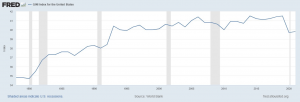
Bair concludes that the Fed should hold interest rates at their current level, on the premise that the upcoming suffering will be well worth it in the long run, as it is a necessary condition for much better times:
The Fed is wise to pause to give our financial system time to adjust. Higher rates will help our economy, but a financial crisis could devastate it. Once we get through this transition, the Fed should fundamentally reassess its belief that a single-minded pursuit of 2 per cent inflation is good for the economy. Any level of inflation erodes real wages, while free money has undercut productivity and sustainable growth. Better that we abandon Zirp for good and rely less on central bankers to run our economies in the future. History, research and plain common sense suggest that we will be better off.
Bair’s observation that it is unwise to let central bankers run our economies is sound advice indeed.
Sources: CNBC; American Institute for Economic Research; The Financial Times
College-Readiness Declines Again
 Scores on the ACT college-readiness test have fallen again, reaching their lowest levels in more than three decades:
Scores on the ACT college-readiness test have fallen again, reaching their lowest levels in more than three decades:
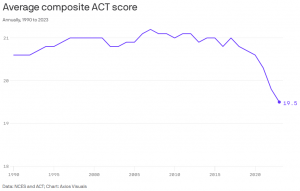
Source: Axios
“The average Composite score on the ACT test fell to 19.5 for the class of 2023, a decline of 0.3 points from 2022, according to data released today by ACT, the nonprofit organization that administers the college readiness exam,” ACT reported on its website. “The average scores in mathematics, reading, and science subjects were all below the ACT College Readiness Benchmarks for those subjects.”
Student achievement scores fell for the sixth straight year, to a 32-year low, and they declined in every subject area, ACT reports:
“This is the sixth consecutive year of declines in average scores, with average scores declining in every academic subject,” ACT CEO Janet Godwin said. “We are also continuing to see a rise in the number of seniors leaving high school without meeting any of the college readiness benchmarks, even as student GPAs continue to rise and students report that they feel prepared to be successful in college. The hard truth is that we are not doing enough to ensure that graduates are truly ready for postsecondary success in college and career. These systemic problems require sustained action and support at the policy level. This is not up to teachers and principals alone—it is a shared national priority and imperative.”
The scores have gone steadily downward:
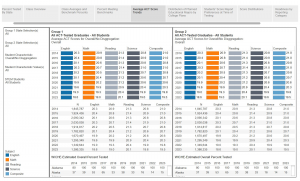
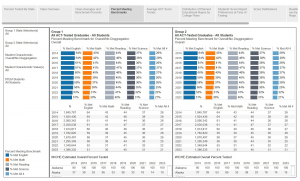
ACT highlights some key findings:
-
- The average Composite score declined by 0.3 points, from 19.8 in 2022 to 19.5 in 2023.
- Between 2022 and 2023, average English scores declined 0.4 points (from 19.0 to 18.6), average mathematics scores declined 0.3 points (from 19.3 to 19.0), average reading scores declined 0.3 points (from 20.4 to 20.1), and average science scores declined by 0.3 points (from 19.9 to 19.6).
- The percentage of students meeting all four benchmarks dropped 1.3 percentage points, from 22.1% of students in 2022 to 20.8% of students in 2023, whereas the percentage of students meeting no benchmarks increased by 1.7 percentage points, from 41.6% in 2022 to 43.3% in 2023.
Students are falling far short of the achievement levels needed for college success. Meanwhile, the Biden administration and the higher education complex press to push more people into college even though more than one-quarter of all programs have a negative return on investment and academic standards in higher ed are falling and student performance is “abysmal,” as the education economist Richard Vedder put it.
A lack of money is not the cause of the decline in achievement, the Committee to Unleash Prosperity notes:

ACT was quick to blame the declines on the pandemic, noting that the 2023 graduating class is the first one to have spent their freshman year during the lockdown era, with all the disruptions that created. The achievement declines, however, began well before the pandemic and have been disturbingly rapid, as is especially clear in the benchmark numbers. The continual, long-term declines indicate that something has gone very wrong with the nation’s education system and has yet to be addressed.
Parents, students, and taxpayers should be outraged. Many are.
Sources: ACT; Heartland Daily News
Biden Whacks For-Profit Higher Ed
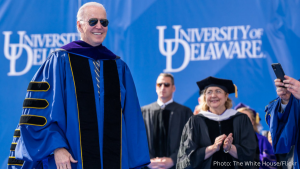 The Biden administration is trying to drive all for-profit higher education institutions out of business, The Wall Street Journal (WSJ) editorial board notes:
The Biden administration is trying to drive all for-profit higher education institutions out of business, The Wall Street Journal (WSJ) editorial board notes:
The Education Department recently finalized a 775-page rule that restricts federal financial aid to proprietary colleges that purportedly fail to prepare students for “gainful employment.” The Obama Administration’s first such rule was blocked in federal court, and Trump Education Secretary Betsy DeVos rolled back its redo.
The Biden rule “could shut down most of the survivors” of the “assault by Obama regulators and Democratic state Attorneys General” that cut for-profit college enrollment from 1.7 million in 2010 to 777,400 students between 2010 and 2021, WSJ notes.
Perhaps these institutions should be held to higher standards if taxpayers are going to support them by guaranteeing student loans, providing Pell grants, and giving them state tax money. Unfortunately, accountability and fiscal probity are not the motives behind the Biden administration’s rule. Not by a long shot. If the rule were intended to ensure government money is well-spent, it would apply to all institutions of higher education, not just the tiny for-profit sector, the Journal’s editors rightly observe:
There might be an argument for protecting taxpayers by limiting federal aid to schools that saddle students with debt they can’t repay. But it would only be fair to apply the rule across all colleges.
If the Biden debt-to-earnings metric were applied equitably—to borrow the left’s buzzword—public and not-for-profit colleges would account for nearly 80% of failing undergraduate degree programs. …
The department also excludes earnings of graduates who go on to earn higher degrees. If this metric were applied across all colleges, public and not-for-profits would account for 90% of programs that would fail. Examples include Rutgers (cellular biology), Emory University (neurobiology) and University of Michigan (philosophy). Fine and studio arts programs at the University of Kansas, Florida International University, University of Florida, Stony Brook University, and George Washington University, among others, would fail. Certain fields result in relatively low earnings no matter what type of institution grants the degree.
Conclusion: the Biden administration, like the Obama administrations before it, is on a crusade to “eliminate for-profit colleges and drive their students into nonprofit and public colleges that are often no better on gainful employment,” as the WSJ editorial concludes.
Many young people who are considering voting for Biden in 2024 will get hit hardest by the new rule: “The metric would punish schools for enrolling low-income students who typically take out more debt because their parents aren’t helping,” the WSJ editorial board notes.
In the minds (such as they are) of Biden and his control-freak cronies, government is always better than freely chosen arrangements.
Source: The Wall Street Journal
From ‘End of History’ to End of Civilization
 Is the entire world is going “back to blood” and careening rapidly toward the end of civilization, of which the Hamas atrocities are the latest manifestation? Noting that there is no liberty without civilization, two of my Heartland Institute colleagues and I discuss the rising violence around the world, in the institute’s latest In the Tank podcast.
Is the entire world is going “back to blood” and careening rapidly toward the end of civilization, of which the Hamas atrocities are the latest manifestation? Noting that there is no liberty without civilization, two of my Heartland Institute colleagues and I discuss the rising violence around the world, in the institute’s latest In the Tank podcast.
Here is the official description:
The unfathomable evil of Hamas’ attack on Israel last week was a reminder that the eternal human struggle between civilization and savagery never ends. This is going to be a tough podcast to get through, but it is important to not look away from the hate and the horrors inflicted by the enemies of civilization. Some say this barbarous act changes the Middle East forever. Maybe. But what does the fight in Israel say about the future of global liberty, which we’ve always assumed would remain ascendent forever? And what are we to make of the overtly pro-Hamas sentiment found in American streets, the halls of Congress, the heights of academia, and other redoubts of the ruling class?
Here is a brief excerpt that indicates what it will take to drive back the rising forces of barbarism:
“What is civilization? Civilization is the putting together of enough strength and power to say, ‘No, this isn’t going to happen here. We’re stopping it.’ And this is the choice that Israel has before it. Either stop it and let the world go where it may and say what it wants, or not.
“And that’s where we are as a nation, the United States. We have these same impulses arising. We have people being dehumanized, we have people sympathetic to the beheading of Jewish babies in a kibbutz, with people expressing sympathy for the people who did that. That’s monstrous. … This is a worldwide phenomenon, and it is going to intensify in the coming years unless and until the forces of civilization decide that they love civilization enough to defend it with their lives.
Heartland Institute Vice President Jim Lakely, Editorial Director Chris Talgo, and I explore how and why world leaders are unleashing the worst impulses of the human heart to pit people against one another in a worldwide death-dealing cage match: to increase their own power and rule over the ashes.
Watch it here:
Source: Civilization vs Savagery—In the Tank Podcast #419
Cartoon



